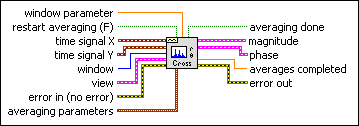 |
window parameter specifies the beta parameter for a Kaiser window, the standard deviation for a Gaussian window, and the ratio, s, of the main lobe to the side lobe for a Dolph-Chebyshev window. If window is any other window, this VI ignores this input.
The default value of window parameter is NaN, which sets beta to 0 for a Kaiser window, the standard deviation to 0.2 for a Gaussian window, and s to 60 for a Dolph-Chebyshev window.
|
 |
restart averaging specifies whether the VI restarts the selected averaging process. If restart averaging is TRUE, the VI restarts the selected averaging process. If restart averaging is FALSE, the VI does not restart the selected averaging process. The default is FALSE. When you call this VI for the first time, the averaging process restarts automatically. A typical case when you should restart averaging is when a major input change occurs in the middle of the averaging process.
|
 |
time signal X is the time waveform X.
|
 |
time signal Y is the time waveform Y.
|
 |
window (Hanning) is the time-domain window to apply to the time signal. The default window is Hanning.
| 0 | Rectangle | | 1 | Hanning (default) | | 2 | Hamming | | 3 | Blackman-Harris | | 4 | Exact Blackman | | 5 | Blackman | | 6 | Flat Top | | 7 | 4 Term B-Harris | | 8 | 7 Term B-Harris | | 9 | Low Sidelobe | | 11 | Blackman Nutall | | 30 | Triangle | | 31 | Bartlett-Hanning | | 32 | Bohman | | 33 | Parzen | | 34 | Welch | | 60 | Kaiser | | 61 | Dolph-Chebyshev | | 62 | Gaussian |
|
 |
view defines how the different results from this VI are returned.
 |
dB On specifies whether the results are expressed in decibels. The default is FALSE.
|
 |
unwrap phase specifies whether to unwrap the phase. Unwrapping eliminates discontinuities that have an absolute value greater than pi. The default is FALSE, meaning the phase is not unwrapped. When unwrap phase is TRUE, the phase is unwrapped.
|
 |
convert to degree specifies whether the phase results are converted from radians to degrees. The default is FALSE, which means that results are expressed in radians.
|
|
 |
error in describes error conditions that occur before this node runs. This input provides standard error in functionality.
|
 |
averaging parameters defines how the averaging is computed. The specifications of the parameters include the type of averaging, the type of weighting, and the number of averages.
 |
averaging mode specifies the averaging mode.
| 0 | No averaging (default) | | 1 | Vector averaging | | 2 | RMS averaging | | 3 | Peak hold |
|
 |
weighting mode specifies the weighting mode for RMS and vector averaging.
| 0 | Linear | | 1 | Exponential (default) |
|
 |
number of averages specifies the number of averages used for RMS and vector averaging. If weighting mode is exponential, the averaging process is continuous. If weighting mode is linear, the averaging process stops after this VI computes the selected number of averages.
|
|
 |
averaging done returns TRUE when averages completed is greater than or equal to the number of averages specified in averaging parameters. Otherwise, averaging done returns FALSE. averaging done is always TRUE if the selected averaging mode is No averaging.
|
 |
magnitude returns the magnitude of the averaged cross power spectrum and the frequency scale.
 |
f0 returns the start frequency, in hertz, of the spectrum.
|
 |
df returns the frequency resolution, in hertz, of the spectrum.
|
 |
magnitude is the magnitude of the averaged cross power spectrum.
|
|
 |
phase returns the phase of the averaged cross power spectrum and the frequency scale.
 |
f0 returns the start frequency, in hertz, of the spectrum.
|
 |
df returns the frequency resolution, in hertz, of the spectrum.
|
 |
phase returns the phase of the averaged cross power spectrum.
|
|
 |
averages completed returns the number of averages completed by the VI at that time.
|
 |
error out contains error information. This output provides standard error out functionality.
|

 Add to the block diagram
Add to the block diagram Find on the palette
Find on the palette











